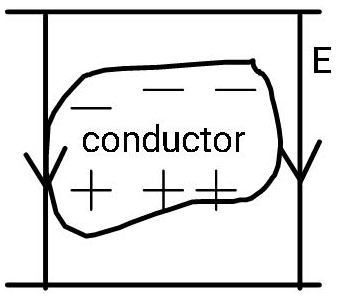Answer
396k+ views
Hint: Electric field is produced due to presence of charges. It is defined as the force acting on a unit charge. Conductors have free electrons that travel on its surface and help in shielding out the electric field.
Complete answer:
If we have a uniform static electric field and we place a test charge in it, the test charge experiences a force on it and moves according to the direction of the electric field. The positive charges tend to move along the direction of the applied electric field and the negative charges tend to move in the direction opposite to the applied electric field.
Suppose if we place a solid conductor in a uniform electric field like below:

We will observe that on the upper surface of the conductor, negative charges appear and on the lower surface of the conductor positive charges appear. A conductor has free electrons that can move around (they do not remain bound to an atom). These electrons tend to redistribute according to the external conditions. In our case we provided an electric field so the electrons felt the attraction and moved to the upper surface, so the lower surface automatically became positively charged due to deficiency of electrons. This creates an opposing electric field inside the conductor which shields out the external electric field.
In the question we are asked about how a hollow conducting sphere would respond to an external electric field. The answer is that it will also redistribute its electrons and shield out the external electric field completely. Therefore, inside the conducting hollow sphere the electric field will be zero. The correct answer is option (A).
So, the correct answer is “Option A”.
Note:
The electric field inside a conductor is zero but the potential inside a conductor is not zero. Therefore if we were asked what would be the potential inside the conductor we would have to do some calculations in that case. The potential inside will be the same as on the surface of the conductor.
Complete answer:
If we have a uniform static electric field and we place a test charge in it, the test charge experiences a force on it and moves according to the direction of the electric field. The positive charges tend to move along the direction of the applied electric field and the negative charges tend to move in the direction opposite to the applied electric field.
Suppose if we place a solid conductor in a uniform electric field like below:

We will observe that on the upper surface of the conductor, negative charges appear and on the lower surface of the conductor positive charges appear. A conductor has free electrons that can move around (they do not remain bound to an atom). These electrons tend to redistribute according to the external conditions. In our case we provided an electric field so the electrons felt the attraction and moved to the upper surface, so the lower surface automatically became positively charged due to deficiency of electrons. This creates an opposing electric field inside the conductor which shields out the external electric field.
In the question we are asked about how a hollow conducting sphere would respond to an external electric field. The answer is that it will also redistribute its electrons and shield out the external electric field completely. Therefore, inside the conducting hollow sphere the electric field will be zero. The correct answer is option (A).
So, the correct answer is “Option A”.
Note:
The electric field inside a conductor is zero but the potential inside a conductor is not zero. Therefore if we were asked what would be the potential inside the conductor we would have to do some calculations in that case. The potential inside will be the same as on the surface of the conductor.
Recently Updated Pages
Basicity of sulphurous acid and sulphuric acid are

Assertion The resistivity of a semiconductor increases class 13 physics CBSE

Three beakers labelled as A B and C each containing 25 mL of water were taken A small amount of NaOH anhydrous CuSO4 and NaCl were added to the beakers A B and C respectively It was observed that there was an increase in the temperature of the solutions contained in beakers A and B whereas in case of beaker C the temperature of the solution falls Which one of the following statements isarecorrect i In beakers A and B exothermic process has occurred ii In beakers A and B endothermic process has occurred iii In beaker C exothermic process has occurred iv In beaker C endothermic process has occurred

The branch of science which deals with nature and natural class 10 physics CBSE

What is the stopping potential when the metal with class 12 physics JEE_Main

The momentum of a photon is 2 times 10 16gm cmsec Its class 12 physics JEE_Main

Trending doubts
Difference between Prokaryotic cell and Eukaryotic class 11 biology CBSE

Difference Between Plant Cell and Animal Cell

Fill the blanks with the suitable prepositions 1 The class 9 english CBSE

Change the following sentences into negative and interrogative class 10 english CBSE

Give 10 examples for herbs , shrubs , climbers , creepers

What organs are located on the left side of your body class 11 biology CBSE

Write an application to the principal requesting five class 10 english CBSE

What is the type of food and mode of feeding of the class 11 biology CBSE

Name 10 Living and Non living things class 9 biology CBSE



